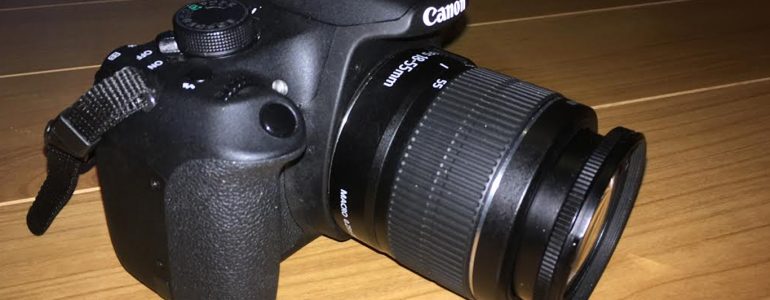This year’s devices have been a great proof of how the photography market is only growing. With more and more aficionados, the manufacturers have become more aware of their necessities. And what do young photographers need? Versatility, of course.
Just like other brands, Canon has been a pertinent contributor in the making of more adaptable devices. There are two great things about these types of cameras: they work for both professionals and amateurs, and they are cheaper than the rest!
This time, we are going to make an overview of a camera I believe is great to start with: we are talking about the Canon EOS 1300D (also known as the Canon T6 Rebel in other countries). Let’s take a look at the best features of this device.
Sensor: More than a decent image quality
Despite being a beginner’s camera, the 1300D has a great CMOS 18MP with one of the most common types of image processors: a DIGIC 4+. Why is this processor so used in the manufacturing of these devices? Basically because they provide a good speed and an amazing quality image.
To benefit the shooting of objects/subjects in movement, the camera allows you to shoot at 3fps. Whether you want to take photographs in a RAW or a compressed format, you will have several shots of a sequence or a still image.
Besides, this sensor provides the possibility of shooting comfortably in low light conditions, thanks to its maximum ISO sensitivity 6400. Which can be extended up to 12800, by the way.
Lens: Two available choices
1300D is usually offered with two types of lenses: a standard one (with a normal range of 18-55mm) and a higher one with a focal range of 70 to 300mm. They both work as an excellent part of the gear for the camera.
The 18-55mm lens provides a minimum aperture of f/3.5, which means it’s very luminous and can take great shots in the dark, helping itself with the highest ISO sensitivity of the camera. You can give it a try without a tripod at some occasions, since it has an image stabilizer.
The 70-300m lens, on the other hand, has a lower minimum aperture of f/4 (remember the lower the number, the bigger the aperture), which means it can be slightly less luminous than the previous one, but just as good!
Both lenses are wonderful options for still shooting and video recording, thanks to the different camera features and lenses’ image stabilizer and internal composition.
Video: More than enough for a passionate videographer!
So it’s not the best video quality there can be, but you won’t be disappointed with it either. Though it does lack from 4K video, which is the most recent update in video world, you can find a maximum Full HD resolution of 1080p at 30fps.
And as we said before, you can easily get great recordings thanks to other cameras systems. For instance, the autofocus feature will easily help you to record movement without having an intermittent focus within a same scene. And the fact that the processor is there, means you will find satisfactory quality. More than enough for a curious videographer!
Autofocus: By Phase Detection
Plenty of cameras nowadays are including a hybrid (also called mixed) autofocus system, that works with both phase and contrast detection. However, the 1300D has settled with a 9-point AF system (just phase detection).
Sure, it may seem that it has some cons because it does not involve both systems, but surely the camera has a convincing mechanism. Though it has a cross-type 9-points phase detection system, it’s designed to work well with both low and high contrast scenes.
This means that ideally you could work with any type of scene, regardless of the absence of a sharp contrast within it. Unlike plenty of autofocus systems which cannot function properly under low contrast situations.
Not only this, but the camera includes another proper alternative for people who are into video and shooting objects or subjects in movement: you can use a popular mechanism called AF Servo AF. This feature works with a faster movement tracking, locking subjects and hence, much better results.
Connectivity: Connect with devices and people in two different ways
Connectivity is something we definitely should hope for in every recent launching of manufacturers. The Canon 1300D has two types of connection with devices: NFC (Near Field Communication) and Wi-Fi connection. You can easily control your camera via smartphone or tablet through any of these. If you are shooting in a remote place, say a forest, NFC will be logically more helpful.
Now, the Wi-Fi option is useful for more than that because it actually allows you to immediately share your pictures or videos online. Always getting close to the new standards of online communications, Canon has managed to include this feature in plenty of its recent devices.
LCD Screen: A great tool to monitor everything
Besides having a viewfinder, it also has a big 3 inch LCD screen which allows to monitor every movement or change taken in the scene. You can also go through the menu and adjust different settings, as you normally do in other cameras.
Why should you get the Canon EOS 1300D?
Versatility, good quality image, non-expensive and easy-to-use device
With all of these features, it’s needless to say that the Canon EOS 1300D could be a good purchase for anyone who is into photography. However, I’d reaffirm that if you are getting a camera for the first time, this one is ideal.
Another recommendation is to get it with the 18-55mm lens first, in order to experience a better handling of the focal distance. You can add the 70-300mm lens to your later gear!

